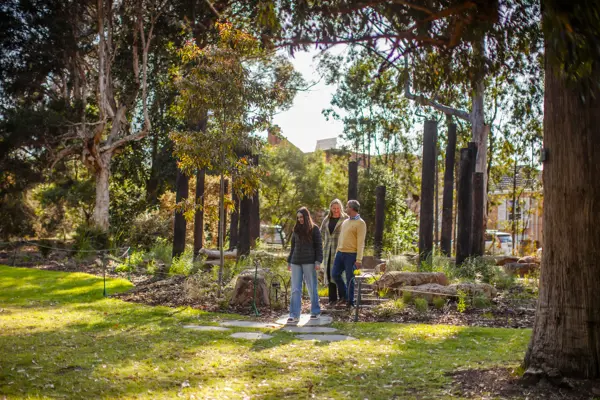
Royal Botanic Gardens Melbourne creates new Australian Drylands to transition for a future warmer climate
Royal Botanic Gardens Melbourne has opened its new Australian Drylands landscape as it continues to transition the Gardens for a future warmer climate.
With Melbourne’s temperature in 2070 expected to be 3.0°C higher – akin to present day Dubbo – and with 15% less rainfall, around a quarter of species in the Gardens today may not survive.
Minister for Environment, Steve Dimopoulos said that "We're proud to support initiatives that enhance our understanding of climate change and help preserve Victoria's unique biodiversity. Royal Botanic Gardens' Australian Drylands project is a shining example of how we can adapt to the challenges of climate change by using cutting-edge tools and knowledge to protect our native flora and shape a greener future for all Victorians."
Gardens Director and Chief Executive, Chris Russell, says that the Gardens is transitioning its landscape now to stay the same.
Chris Russell, Gardens Director and Chief ExecutiveWe are acting now to preserve the Gardens that Melbournians have loved and enjoyed for over 175 years.
He says that the Australian Drylands also will assist other botanic gardens with climate change adaptation.
“The Drylands will provide other botanic gardens and arboreta around the world with a best practice model for landscape succession,” he said.
Located near Domain Gate, the Australian Drylands is more than 2,500 sqm and includes plants collected from Queensland, NSW and WA, many of which are new to the Gardens.
Curator of the collection and Horticulturist, Georgie Moyes, says that the Drylands will provide valuable information about the suitability of various plants to Melbourne’s future climate.
“The Drylands contains plants that are outside their normal temperature range, which allows us to collect information, and share this with other botanic gardens,” she said.
Georgie Moyes, HorticulturistWe are testing Dasypogon bromeliifolius, commonly known as Pineapple Bush, along with other Western Australian plants that come from a hotter climate and grow on sandy soils, as well as Xylomellum occidentale known as Woody Pear, which is new to the Gardens.
The Australian Drylands is guided by Royal Botanic Gardens Victoria’s Landscape Succession Strategy 2016-2036, which sets ambitious targets to adapt Melbourne Gardens to a warmer climate. This includes a target of 75% of plants by 2036 that are suited to a warmer climate, as well as targets for plant diversity, sustainable water, landscape design and education.
In 2018, Royal Botanic Gardens Victoria led a new Climate Change Alliance of Botanic Gardens, which brings together over 400 botanic gardens from around the world, to share information and respond to climate change.
The Alliance has created a Landscape Succession Toolkit and Climate Assessment Tool which provides a world-first framework for other land managers to adapt to climate change.
“We conducted extensive research and combined this with the Climate Assessment Tool to select the plants for this project,” said Ms Moyes.
She says that the Drylands is a wonderful place to be inspired by the diversity of Australian natives, their flowers, colours and textures.
“Anigozanthos manglesii commonly known as red-and-green Kangaroo Paw from Western Australia is looking brilliant, there are lots of different Prostantheras in flower, and it is relaxing to sit on the logs and be surrounded by beautiful Australian natives,” she said.
Critically endangered and endangered Victorian plant species have also been planted in the garden for education and display purposes.
“We have planted Grevillea bedggoodiana, commonly known as Enfield grevillea, with its beautiful red flowers, Phebalium glandulosum subsp. macrocalyx, which we collected in Swan Hill, Victoria, among others,” she said.
The new area includes a winding walkway as well as two outdoor seating spaces; one includes a fire pit and tells the story of fire adaptation, and the other showcases Australian palms and cycads.
Planning is also underway for a Learning Hub at the Drylands, including bathroom facilities and an AV screen, where Gardens Learning Facilitators will be able to educate children about how they can protect plants and the planet.
The area was designed by Gardens long-term and respected landscape architect, Andrew Laidlaw.
The project was made possible thanks to generous donors.
Steve Dimopoulos, Minister for EnvironmentWe're proud to support initiatives that enhance our understanding of climate change and help preserve Victoria's unique biodiversity. Royal Botanic Gardens' Australian Drylands project is a shining example of how we can adapt to the challenges of climate change by using cutting-edge tools and knowledge to protect our native flora and shape a greener future for all Victorians.
Steve Dimopoulos, Minister for EnvironmentWe’ve done more than any previous government in Victoria to stop the decline of native plants and animals through our Biodiversity 2037 plan, backed by a record $609 million investment to conserve our precious natural environment since 2014.
About Royal Botanic Gardens Melbourne
Royal Botanic Gardens Melbourne has been a treasured part of Melbourne’s cultural life for more than 170 years – much loved by generations of Victorians, as well as by many visitors from interstate and overseas. It is a picturesque haven for recreation and an important resource for education, conservation, science and horticulture.
Melbourne Gardens extends over 38 hectares and houses a collection of more than 8,500 species of plants from around the world, including amazing and diverse plant collections such as camellias, rainforest flora, cacti and succulents, roses, Californian species, herbs, perennials, cycads, plants from Southern China and, in the Rare and Threatened Species Collection, plants from south-eastern Australia.
Entry is free.
Open from 7:30am-5:30pm daily.
From Tuesday 1 October, Melbourne Gardens will close at 7:30pm for daylight savings.
